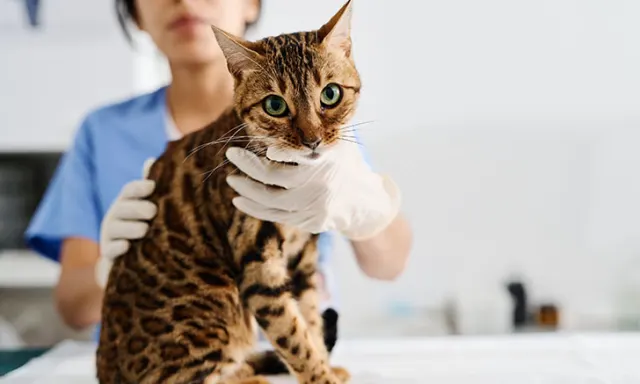Top 5 Tips for Addressing Feline Osteoarthritis in Practice

Sponsored by Zoetis
Awareness around feline osteoarthritis (OA) and its effect on patient quality of life is growing, leading to a greater awareness of the need to implement convenient, safe, and effective management protocols.
Use these 5 tips to successfully turn OA screening and treatment into a priority in practice.
1. Start Screening Young
OA is a common feline disease, with 90% of cats >12 years of age showing radiographic evidence of OA.1-4 However, OA is not restricted to geriatric cats.1-3 Although OA is often viewed as a disease of age, clinical studies have shown that cats as young as 2 years of age can suffer from OA,5 with an estimation that nearly 40% of all cats have clinical signs of OA.1 Early screening can help identify cats suffering from the disease sooner and allow for better long-term control of OA pain.2,6
In addition, early screening serves the important purpose of raising OA awareness. Regular discussions regarding the prevalence of OA in cats and its effect on quality of life can help owners remain alert for its signs and motivated to make an appointment for any concerns.2,6 These discussions can also help initiate discussions about the importance of a multimodal treatment approach that controls OA pain, maintains mobility, and slows progression, driving home the need for early preventive measures (eg, weight management, lifestyle modification).2,6,7
2. Incorporate Previsit Checklists
Despite its prevalence, feline OA remains underdiagnosed, likely in part because chronic pain in cats can be notoriously difficult for owners to recognize.2,6,8 Unlike the obvious signs of joint pain cat owners often expect (eg, limping), cats typically display more subtle behavioral changes that may be misinterpreted as “slowing down” attributed to normal aging (eg, difficulty or hesitation jumping up/down, difficulty chasing moving objects).2,6,8 Central to OA diagnosis is owner observation and reporting of these changes seen at home.6,8
Previsit questionnaires sent to owners (via email or text link) can give owners time to thoughtfully monitor their cats at home while also educating owners about how chronic pain presents in cats. Questionnaires can be quite simple, incorporating observation of a few key behaviors that tend to be impacted by OA pain (eg, jumping up/down, walking up/down stairs).8 Results can be saved in the patient’s record and compared over time to identify any concerning trends.
3. Create a Low-Stress Environment to Aid in OA Examinations
OA pain can be challenging to detect on examination because cats may be unlikely to demonstrate affected behaviors and tend to hide pain in stressful situations.6,8 Creating a low-stress environment may encourage patients to move around the room, allowing for mobility observations.2,6,9 Nonslip surfaces, pheromones, and treats can all encourage cats to get out of their carrier and explore their environment.9 History discussions also provide an opportunity to observe mobility and posture before starting the hands-on portion of the examination.9 During the orthopedic examination, low-stress handling techniques (eg, allowing the cat to remain in the position they feel most comfortable) can also help keep cats more relaxed, aiding in the detection of subtle changes in behavior (eg, tensing, vocalizing, shifting away).6,9
4. Leverage the Newest Treatment Options
Although pain management therapy is a cornerstone of multimodal OA treatment, it can be challenging in cats.1,2 Daily medications may be difficult to administer, creating aversions to the food or handling associated with it that may disrupt the human–animal bond.2,6 Although NSAIDs are often a go-to choice for OA treatment for many species, none are approved in the United States for long-term use to treat chronic pain in cats, and they may raise concerns for patients with renal disease.1,2,6
Monoclonal antibodies targeting nerve growth factor (NGF) can help overcome these treatment challenges. NGF is a key player in pain signaling in adult animals via a novel OA pain pathway that is separate from the more commonly known prostaglandin pathway and is found in higher concentrations in chronically diseased joints.1,2,10 Monoclonal antibodies are eliminated via normal protein degradation pathways, with minimal involvement of the liver or kidneys, providing a safe and effective treatment option.11 Seventy-seven percent of cat owners in a 3-month study saw improvement in signs of pain when their cats were treated monthly with Solensia.1,12* Importantly, Solensia™ (frunevetmab injection), the first and only monoclonal antibody for control of feline OA pain, is a once-monthly injection that can help eliminate the need for daily medication struggles.12
5. Implement Regular Follow-Up
Even with the convenience of once-monthly injections, compliance with repeated appointments may still pose a challenge. Regular check-ins posttreatment may help clients track progress and recognize behavioral improvement while also serving as a reminder for injections coming due. Practice software can be set to prompt the veterinary team with follow-up phone calls at predetermined times postinjection. Alternatively, easily downloadable Solensia emails can be triggered to send at set timepoints.13
For some cats, a fear of crates, travel, or the hospital may act as a barrier to future injections.14 Regular follow-up is another touchpoint to identify these concerns and provide education and support.14 Owners can be instructed in crate-training tips (eg, pulling crates out in advance to the appointment, using pheromones), and previsit anxiolytic medications can be prescribed as needed.14
Conclusion
Implementing simple OA screening and treatment protocols can turn OA management into routine feline preventive care in any practice. With the help of new OA treatment advances, convenient and effective OA pain control is now a possibility for all cats.
*67% of cat owners reported improvement in signs of their cat's pain in the placebo group.
IMPORTANT SAFETY INFORMATION
For use in cats only. Women who are pregnant, trying to conceive or breastfeeding should take extreme care to avoid self-injection. Hypersensitivity reactions, including anaphylaxis, could potentially occur with self-injection. SOLENSIA should not be used in breeding cats or in pregnant or lactating queens. SOLENSIA should not be administered to cats with known hypersensitivity to frunevetmab. The most common adverse events reported in a clinical study were vomiting and injection site pain. See full Prescribing Information, SolensiaPI.com
